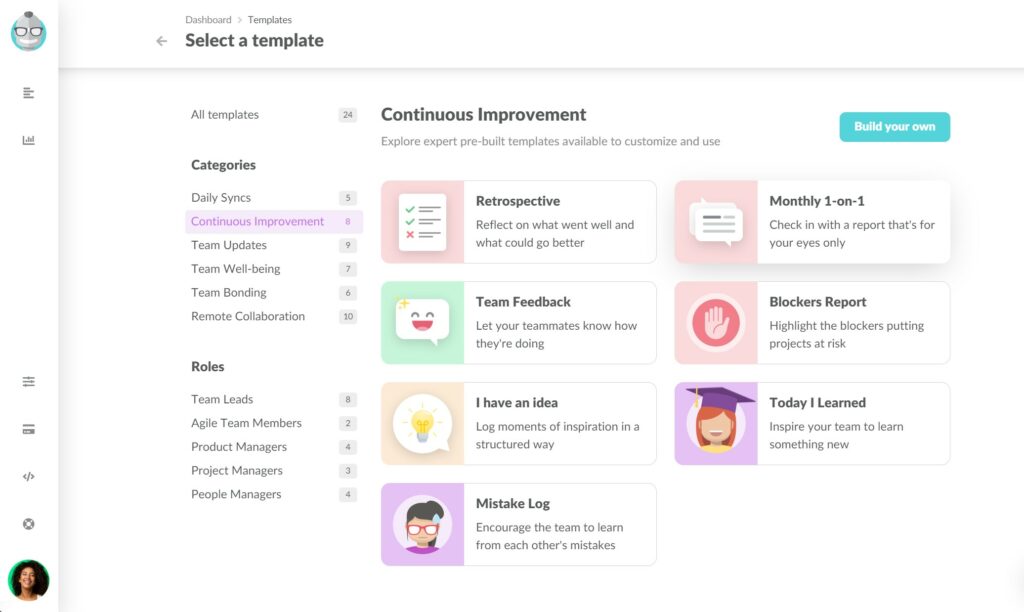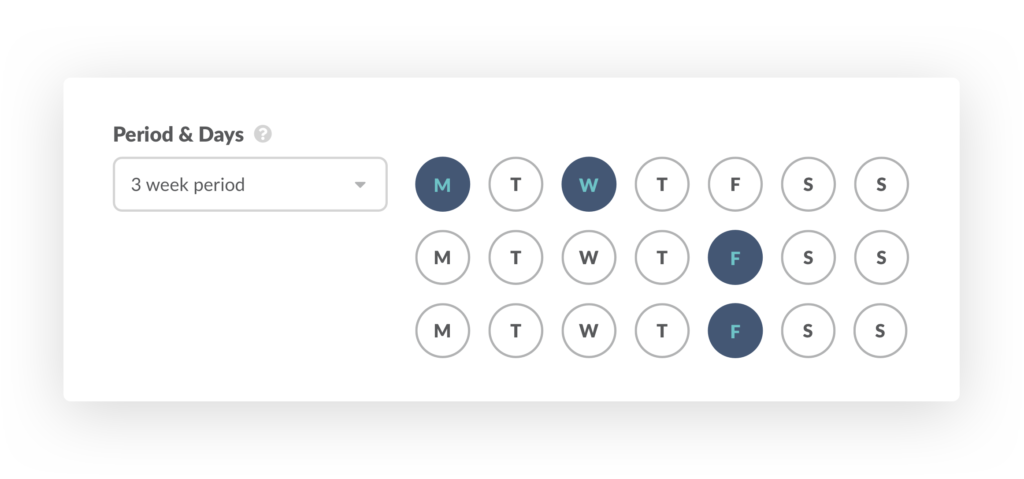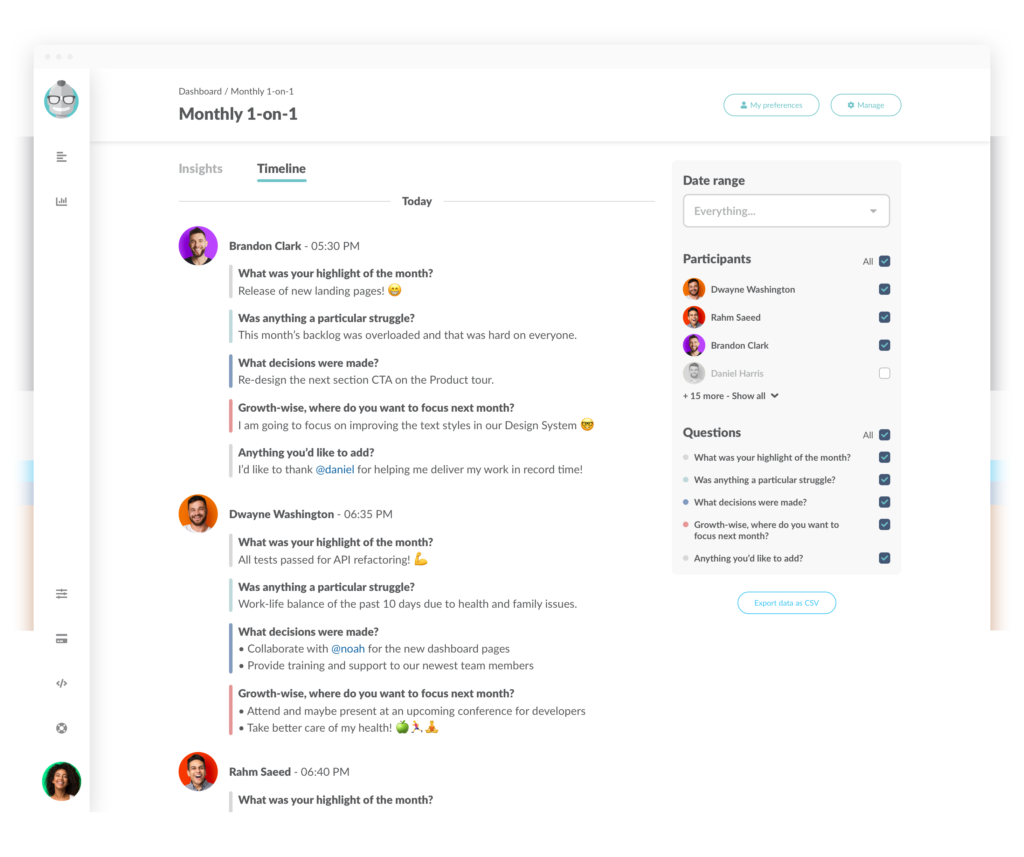How many 1v1 meetings are you running with your team every month?Everyone knows that checking up on your co-workers is a crucial part of a healthy remote culture. And Google’s Project Oxygen clearly demonstrates that high-performing managers favor 1:1 meetings more often than low-performers.
Yet so many team leaders struggle to make their 1-on-1’s work. Why is that?
Short answer: consistency and preparation.
As it turns out, it’s challenging for leaders to execute 1v1s consistently well. It goes like that: the very first meetings with employees start as something fresh and unique, but over time these meetings tend to turn into dull status report meetings, or worse, blamestorming sessions.
In addition to that, efficient 1-on-1 meetings require a great deal of preparation. Managers need to know what to focus on during the discussion with a particular employee and maintain a log of previous sessions to track progress.
Without consistency and preparation 1-on-1 meetings are prone to becoming obsolete. So how do you keep your 1:1 useful, engaging, and regular?
In this article, we’ll talk about how to conduct 1v1 meetings that your employees are looking forward to. We’ll also help you analyze the efficiency of your meetings and regularly improve their positive impact with the help of our latest Geekbot 1-on-1 feature.
But first, let’s understand where the majority of 1v1 meetings fall short.
Where do the majority of 1v1 fall short?
- Failure to recognize employee achievements. HBR research lists “not recognizing employee achievements” as the #1 reason for ineffective leadership. It can be hard to balance praise and critical feedback and even more challenging to do so consistently over time.
- Not actionable enough. Many meetings, 1-on-1 included, fail to become actionable. After all, what’s the point of discussion if anything stays the way it was? Employees recognize this catch — no wonder they list “absence of clear directions” as the second most common trait of ineffective leadership.
- Too long. Following Project Oxygen Study insights, Google teams favor short 30-60 minutes sessions as the most effective format for 1-on-1 meetings. Unfortunately, this is where many leaders tend to fall off by dragging discussion for too long or keeping them too short and superficial.
- Low engagement. Low engagement is a common trait of ineffective meetings . Worse yet, low engagement during sessions often transcends into low engagement during work. No wonder productivity losses amount to an astonishing 500 billion dollars every year.
- Lack of purpose. US purpose study found that purpose-oriented employees have higher levels of fulfillment in their work. At the same time, Deloitte found that mission-driven companies have 30% higher levels of innovation and 40% higher retention levels. Sadly, many 1-on-1’s lack both focus and purpose and require extra effort to bring it back.
Almost all of these issues pop up because managers tend to wing their 1-on-1 sessions. They schedule a time, invite an employee, and try to figure out stuff on the go. The result is a conversation that rarely leads anywhere or produces any real impact.
Efficient 1-on-1 sessions need to have a goal, a rhythm, and a structure.
A goal helps you keep the conversation around the most pressing issues your employees have. A rhythm helps managers hold 1-on-1 sessions regularly and track their impact over time. A structure allows these meetings to be short yet engaging.
And while you can’t automate interpersonal meetings with employees [neither you should], there’s a way to make your 1-on-1 sessions more efficient: come prepared.
That’s exactly why we developed our monthly 1-on-1 Geekbot template that helps you take your 1-1 meetings to the next level.
Here’s how it works.
How to Consistently Nail 1v1 Meetings: Geekbot 1-on-1’s
With the latest Geekbot Monthly 1-on-1 feature, you can prepare for effective one-on-one meetings directly in Slack. Regularly and with no extra time spent.
Step 1: Decide Which Questions You’d Like to Send
We offer a list of questions that your employees receive before the actual 1-on-1 meeting starts. You can select from our library of prepared questions or add some of your own.
Sending these questions allows you to learn about what your employees experience or want to discuss:
- What was your highlight of the month?
- Was anything a particular struggle?
- Any blockers I can help remove?
- Were you on track with your goals this month?
- What was least clear to you in terms of team priorities?
- If there was one thing I could do to help you, what would it be?
- On a scale of 1-10, how happy are you with your work-life balance?
- How can we get you closer to 10?
- Growth-wise, where do you want to focus next month?
- Anything you’d like to add?
Note : we have created a predefined list of questions for filling the template faster.

Step 2: Configure Geekbot’s Settings
You can set your own schedule and run these meetings as often as you conduct 1-on-1 meetings.

Step 3 : Team member Receives and Answers Questions in Slack
After Geekbot sends questions as per schedule, your employees answer them directly in Slack whenever they have time.

Hint: The answers can be also private, so that participants can be more open and honest.
Geekbot then gathers all the responses in a designated channel for team leaders to analyze. After glancing over the answers you can quickly establish the roadmap for the upcoming 1-on-1 session so that you know exactly what to focus on during the meeting.
The bonus point is that the same channel will contain previous responses so you can always come back, remember what issues you discussed before, and track progress.
You can also use Geekbot’s dashboard to filter responses by date, participant, or question.

The best part is that all that happens on autopilot: once configured, Geekbot will keep providing you with all the necessary data before every meeting.
Why do we think this approach is more efficient for remote teams?
There are several reasons for that.
- Reason #1: Save time. Team members spend up to 4 hours to prepare for meetings every week. This is a massive setback for both team productivity and efficiency. The Slack approach feels lighter to workers, and team members can provide feedback within minutes, while managers quickly establish personalized 1on-1 meeting agenda for every employee.
- Reason #2: Create a focus and purpose. How many times did you start a meeting with someone and were winging it the whole way without direction or purpose? With Geekbot 1-on-1 you can test the waters by analyzing team responses and decide what the meeting should be focused on or where you can be of most help to your employees.
- Reason #3: Track team dynamics over time. Analyzing a series of 1-on-1’s can help you spot patterns or issues long before they turn into full-scale productivity killers. But it takes too much time to create meeting notes for every 1-on-1. With Geekbot, you have a full history of responses in one place, ready for analysis.
Why Regular 1-on-1 Are So Much More Important in 2021?
Over the last year, the global workforce experienced a series of crises with no opportunity to prepare for anything.
Forced switch to remote work, a constant state of uncertainty, and tough choices affected every company and team member. No wonder many employees feel demotivated, uninspired, and plain burnout.
But in times like these, outstanding leadership indeed shows itself: team leaders and colleagues need to keep in touch with each other and swiftly react to incoming challenges.
No automation should replace regular interpersonal meetings with your colleagues, and a manager’s responsibility is to take these 1-on-1 meetings to their utmost potential and make them as useful and engaging for your employees as possible.
Our 1-on-1 Geekbot feature allows you to do just that: keep your 1-on-1 meetings efficient, engaging, and focused on employees.
Want to learn more? Check out our free Geekbot trial and see for yourself how asynchronous standups, retrospectives, and one-on-one meetings can run effectively and hassle-free directly in your Slack.
Frequently asked questions
How do you conduct a 1-on-1 meeting?
1-on-1 meetings can be conducted in person or via team communication tools such as Slack or MS Teams. 1-on-1 sessions must take place regularly to be effective. A common focus of 1-1's includes current goals and progress towards them, recent feedback, recognition, monthly or quarterly performance reports, professional aspirations, etc.
How do I run a one on one meeting?
Every one-on-one meeting should start with a plan. There are no random questions during 1-on-1 — every question should help close the gap between the manager’s expectations and employee aspirations. Divide your 1-on-1 meeting into stages: check-in, discussion, and actionable output. After that, outline the list of most important questions for every stage.
What is the structure of your 1-on-1s?
A typical 1-on-1 begins with check-in to learn more about the current state of the employee. Then goes a status update, or progress update, where employee shares their progress since the last 1-on-1 or last month. Next, identify their current struggles. Allocate time to recognize employee wins. Wrap up the 1-on-1 meeting by creating a list of actionable items that will be reviewed during the next meeting.



